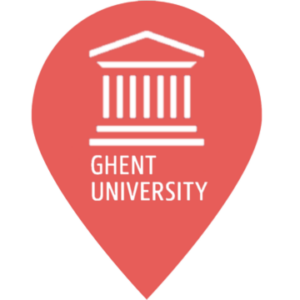
Partner:
Ghent University – Department of Information Technology
Ghent Living Lab
The Ghent Public Open Space living lab will be centred on urban green users as there is a particular interest for people using such spaces, which often struggle to survive in the urban realm because they are exposed to a broad range of environmental polluters (e.g., particulate, noise, etc.).
The Ghent living lab is different from the other case studies of the C3Places network, because it does not necessarily look at a single “physical” place, but rather at a system of places and their virtual (and social) counterparts. One of such (meta)spaces is located in
Ghent in a public park and square that connect to the newly build library of the future “De Krook” that also houses experience labs of Ghent University and IMEC. It is supported by the broader Ghent Living Lab initiative.
Classifying urban public spaces according to their soundscape
Authors: Kang Sun, Karlo Filipan, Francesco Aletta, Timothy Van Renterghem, Toon De Pessemier, Wout Joseph, Dick Botteldooren, Bert De Consel
Cities are composed of many types of outdoor spaces, each with their distinct soundscape. Some of these soundscapes can be extraordinary, others are often less memorable. However, most locations in a city are not visited with the purpose of experiencing the soundscape. Consequently, the soundscape will not necessarily attract attention. Existing methods based on the circumplex model of affect classify soundscapes according to the pleasure and arousal they evoke, but do not fully take into account the goals and expectations of the listener. Therefore, in earlier work, a top-level hierarchical classification method was developed, which distinguishes between spaces based on the degree to which the soundscape creates awareness of the acoustical environment, matches expectations and arouses the listener.
This paper presents the results of an immersive laboratory experiment, designed to validate this classification method. The experiment involved 40 participants and 50 audiovisual recordings drawn from the Urban Soundscapes of the World database.
It is shown that the proposed classification method results in clearly distinct classes, and that membership to these classes can be explained well by physical parameters, extracted from the acoustical environment as well as the visual scene.
Sun, K., Filipan, K., Aletta, F., Van Renterghem, T., De Pessemier, T., Joseph, W., … De Coensel, B. (2019). Classifying urban public spaces according to their soundscape. In M. Ochmann, M. Vorländer, & J. Fels (Eds.), Proceedings of the 23rd International Congress on Acoustics : integrating 4th EAA Euroregio 2019 : 9-13 September 2019 in Aachen, Germany (pp. 6100–6105). Aachen, Germany: Deutsche Gesellschaft für Akustik.
Interactive soundscape augmentation of an urban park in a real and virtual setting
Authors: Timothy Van Renterghem, Kang Sun, Karlo Filipan, Kris Vanhecke, Toon De Pessemier, Bert De Consel, Wout Joseph, Dick Botteldooren
Inappropriate soundscapes are able to strongly deteriorate the user experience in parks. A possible remediation is adding positively perceived sounds.
The case of an urban park, fully surrounded by road traffic noise sources, was studied to explore the potential of adding natural sounds in an interactive way. A preliminary test was conducted in the lab with Virtual Reality (VR) glasses and headphones.
The audio-visual representation of the real environment was obtained by combining binaural recordings with first-order ambisonics and 360-degree video camera footage.
The users were allowed to mix in eight types of natural sounds until their personal optimized soundscape was composed. This was done in a very similar setup as in the (real) park. The loudspeaker augmenting the sound environment in the park was steered with a smartphone application.
This app ensured the user’s presence near the loudspeaker and allowed to gather more detailed assessments of the perceived sound environment through questionnaires. This combination of experiments allowed checking the validity of VR that is becoming increasingly popular in audio-visual interaction studies. In addition, the most preferred natural sounds and the way they influenced environmental noise perception were analyzed.
Van Renterghem, T., Sun, K., Filipan, K., Vanhecke, K., De Pessemier, T., De Coensel, B., … Botteldooren, D. (2019). Interactive soundscape augmentation of an urban park in a real and virtual setting. In M. Ochmann, M. Vorländer, & J. Fels (Eds.), Proceedings of the 23rd International Congress on Acoustics : integrating 4th EAA Euroregio 2019 : 9-13 September 2019 in Aachen, Germany (pp. 899–903). Aachen, Germany: Deutsche Gesellschaft für Akustik.
Influence of Personal Factors on Sound Perception and Overall Experience in Urban Green Areas. A case study of a cycling path highly exposed to road traffic noise
Authors: Francesco Aletta, Timothy Van Renterghem, Dick Botteldooren
In contemporary urban design, green public areas play a vital role. They have great societal value, but if exposed to undue environmental noise their restorative potential might be compromised. On the other hand, research has shown that the presence of greenery can moderate noise annoyance in areas with high sound levels, while personal factors are expected to play an important role too.
A cycling path bordered by vegetation, but highly exposed to road traffic noise, was here considered as a case study. A sound perception survey was submitted to participants on site and they were subsequently sorted into groups according to their noise sensitivity, visual attention and attitude towards greenery.
The aim of this study was testing whether these three personal factors could affect their noise perception and overall experience of the place. Results showed that people highly sensitive to noise and more sceptical towards greenery’s potential as an environmental moderator reported worse soundscape quality, while visually attentive people reported better quality. These three personal factors were found to be statistically independent. This study shows that several person-related factors impact the assessment of the sound environment in green areas. Although the majority of the respondents benefit from the presence of visual green, policy-makers and planners should be aware that for a significant subset of the population, it should be accompanied by a tranquil soundscape to be fully appreciated.
Aletta, F., Van Renterghem, T., & Botteldooren, D. (2018). Influence of Personal Factors on Sound Perception and Overall Experience in Urban Green Areas. A Case Study of a Cycling Path Highly Exposed to Road Traffic Noise. International Journal of Environmental Research and Public Health, 15(6), 1118. doi:10.3390/ijerph15061118
Can attitude towards greenery improve road traffic noise perception? A case study of a highly-noise exposed cycling path
Authors: Francesco Aletta, Timothy Van Renterghem, Dick Botteldooren
This study was based on an on-site survey along a highly noise exposed cycling path immersed in the green, in close proximity of Antwerp Ring Road in Belgium.
The survey was held at 181 passers-by during a working week in September 2017. The survey included questions about overall cycling/walking experience, perceived loudness of road traffic noise, soundscape appreciation, perceived dominance of sound sources, and overall attitude towards greenery’s potential to reduce noise and improve air quality.
A k-means cluster analysis was performed on the scores of the attitude towards greenery (ATG) questions to create an ATG variable reflecting two profiles of users: “positive” and “sceptical” towards greenery’s potential.
The effect of ATG on overall cycling/walking experience, perceived loudness of road traffic noise, soundscape appreciation and perceived dominance of sound sources was tested through a set of independent samples t-tests. Results show statistically significant differences between the positive and the sceptical group for the dimensions of annoyance and calmness, perceived loudness of road traffic noise and perceived dominance of road traffic sounds and natural sounds.
However, no difference was observed for the two groups in terms of overall cycling/walking experience, suggesting that, for the investigated case, other factors might be playing a role.
Aletta, F., Van Renterghem, T., & Botteldooren, D. (2018). Can attitude towards greenery improve road traffic noise perception? A case study of a highly-noise exposed cycling path. In Proceedings of the 11th European Congress and Exposition on Noise Control Engineering (pp. 2377–2382). Hersonissos, Crete, Greece.
